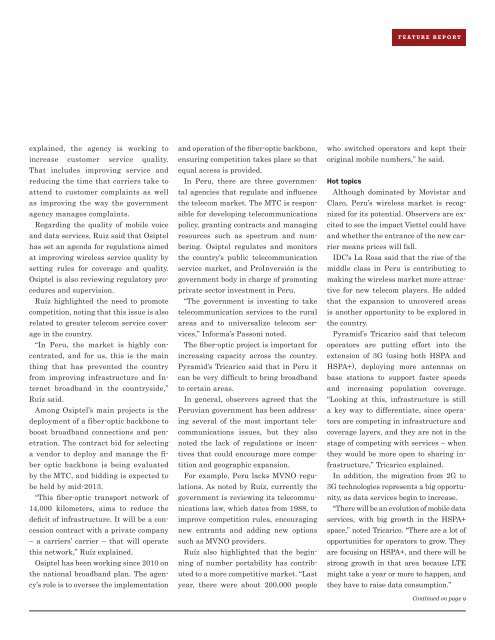Peru: A mobile market set for growth - Prepaid MVNO
Peru: A mobile market set for growth - Prepaid MVNO
Peru: A mobile market set for growth - Prepaid MVNO
Create successful ePaper yourself
Turn your PDF publications into a flip-book with our unique Google optimized e-Paper software.
FEATURE REPORT<br />
explained, the agency is working to<br />
increase customer service quality.<br />
That includes improving service and<br />
reducing the time that carriers take to<br />
attend to customer complaints as well<br />
as improving the way the government<br />
agency manages complaints.<br />
Regarding the quality of <strong>mobile</strong> voice<br />
and data services, Ruiz said that Osiptel<br />
has <strong>set</strong> an agenda <strong>for</strong> regulations aimed<br />
at improving wireless service quality by<br />
<strong>set</strong>ting rules <strong>for</strong> coverage and quality.<br />
Osiptel is also reviewing regulatory procedures<br />
and supervision.<br />
Ruíz highlighted the need to promote<br />
competition, noting that this issue is also<br />
related to greater telecom service coverage<br />
in the country.<br />
“In <strong>Peru</strong>, the <strong>market</strong> is highly concentrated,<br />
and <strong>for</strong> us, this is the main<br />
thing that has prevented the country<br />
from improving infrastructure and Internet<br />
broadband in the countryside,”<br />
Ruíz said.<br />
Among Osiptel’s main projects is the<br />
deployment of a fiber-optic backbone to<br />
boost broadband connections and penetration.<br />
The contract bid <strong>for</strong> selecting<br />
a vendor to deploy and manage the fiber<br />
optic backbone is being evaluated<br />
by the MTC, and bidding is expected to<br />
be held by mid-2013.<br />
“This fiber-optic transport network of<br />
14,000 kilometers, aims to reduce the<br />
deficit of infrastructure. It will be a concession<br />
contract with a private company<br />
– a carriers’ carrier – that will operate<br />
this network,” Ruíz explained.<br />
Osiptel has been working since 2010 on<br />
the national broadband plan. The agency’s<br />
role is to oversee the implementation<br />
and operation of the fiber-optic backbone,<br />
ensuring competition takes place so that<br />
equal access is provided.<br />
In <strong>Peru</strong>, there are three governmental<br />
agencies that regulate and influence<br />
the telecom <strong>market</strong>. The MTC is responsible<br />
<strong>for</strong> developing telecommunications<br />
policy, granting contracts and managing<br />
resources such as spectrum and numbering.<br />
Osiptel regulates and monitors<br />
the country’s public telecommunication<br />
service <strong>market</strong>, and ProInversión is the<br />
government body in charge of promoting<br />
private sector investment in <strong>Peru</strong>.<br />
“The government is investing to take<br />
telecommunication services to the rural<br />
areas and to universalize telecom services,”<br />
In<strong>for</strong>ma’s Passoni noted.<br />
The fiber-optic project is important <strong>for</strong><br />
increasing capacity across the country.<br />
Pyramid’s Tricarico said that in <strong>Peru</strong> it<br />
can be very difficult to bring broadband<br />
to certain areas.<br />
In general, observers agreed that the<br />
<strong>Peru</strong>vian government has been addressing<br />
several of the most important telecommunications<br />
issues, but they also<br />
noted the lack of regulations or incentives<br />
that could encourage more competition<br />
and geographic expansion.<br />
For example, <strong>Peru</strong> lacks <strong>MVNO</strong> regulations.<br />
As noted by Ruíz, currently the<br />
government is reviewing its telecommunications<br />
law, which dates from 1988, to<br />
improve competition rules, encouraging<br />
new entrants and adding new options<br />
such as <strong>MVNO</strong> providers.<br />
Ruíz also highlighted that the beginning<br />
of number portability has contributed<br />
to a more competitive <strong>market</strong>. “Last<br />
year, there were about 200,000 people<br />
who switched operators and kept their<br />
original <strong>mobile</strong> numbers,” he said.<br />
Hot topics<br />
Although dominated by Movistar and<br />
Claro, <strong>Peru</strong>’s wireless <strong>market</strong> is recognized<br />
<strong>for</strong> its potential. Observers are excited<br />
to see the impact Viettel could have<br />
and whether the entrance of the new carrier<br />
means prices will fall.<br />
IDC’s La Rosa said that the rise of the<br />
middle class in <strong>Peru</strong> is contributing to<br />
making the wireless <strong>market</strong> more attractive<br />
<strong>for</strong> new telecom players. He added<br />
that the expansion to uncovered areas<br />
is another opportunity to be explored in<br />
the country.<br />
Pyramid’s Tricarico said that telecom<br />
operators are putting ef<strong>for</strong>t into the<br />
extension of 3G (using both HSPA and<br />
HSPA+), deploying more antennas on<br />
base stations to support faster speeds<br />
and increasing population coverage.<br />
“Looking at this, infrastructure is still<br />
a key way to differentiate, since operators<br />
are competing in infrastructure and<br />
coverage layers, and they are not in the<br />
stage of competing with services – when<br />
they would be more open to sharing infrastructure,”<br />
Tricarico explained.<br />
In addition, the migration from 2G to<br />
3G technologies represents a big opportunity,<br />
as data services begin to increase.<br />
“There will be an evolution of <strong>mobile</strong> data<br />
services, with big <strong>growth</strong> in the HSPA+<br />
space,” noted Tricarico. “There are a lot of<br />
opportunities <strong>for</strong> operators to grow. They<br />
are focusing on HSPA+, and there will be<br />
strong <strong>growth</strong> in that area because LTE<br />
might take a year or more to happen, and<br />
they have to raise data consumption.”<br />
Continued on page 9
















